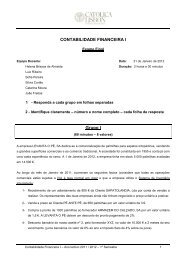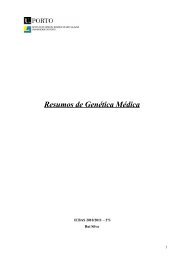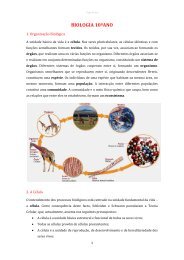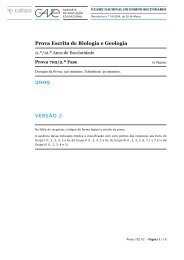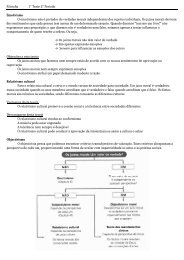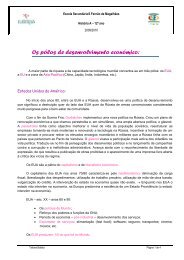MARKETING RESEARCH, 2011/12 - Resumos.net
MARKETING RESEARCH, 2011/12 - Resumos.net
MARKETING RESEARCH, 2011/12 - Resumos.net
You also want an ePaper? Increase the reach of your titles
YUMPU automatically turns print PDFs into web optimized ePapers that Google loves.
International MSc in Business Administration<br />
<strong>MARKETING</strong> <strong>RESEARCH</strong>, <strong>2011</strong>/<strong>12</strong><br />
Fernando S. Machado 20<strong>12</strong>/01/07 Duration: 2h00m+30m<br />
Name: ________________________________________________________ Number___________________<br />
I – Multiple Choice Questions (4.2 points).<br />
1. The Ministry of Finance decides to make an audit. Taxpayers are grouped by €5000 ranges of taxable income.<br />
2000 taxpayers are randomly selected from each income group below €100000. This is called ______ sampling.<br />
a) Systematic.<br />
b) Cluster.<br />
c) Quota.<br />
d) Stratified.<br />
2. Specifying __________ means to translate the problem definition into a precise statement of who should not be<br />
included in the sample.<br />
a) The sampling frame.<br />
b) The sampling unit.<br />
c) The target population.<br />
d) None of the above.<br />
3. A test of the difference between the means of two items in a questionnaire administered to a single sample of<br />
3000 respondents requires a(n):<br />
a) Chi-square test.<br />
b) Independent t-test.<br />
c) F-test.<br />
d) Paired t-test.<br />
4. Focus groups used to help identify factors that consumers consider important in selecting supermarkets represent<br />
________ research design:<br />
a) Exploratory.<br />
b) Descriptive.<br />
c) Causal.<br />
d) None of the above is correct.<br />
5. The following symbolic arrangement indicates: R: X O1<br />
R: X O2<br />
a) Two sets of treatment groups.<br />
b) Dependent variables are to be measured simultaneously.<br />
c) Neither a) or b) are correct.<br />
d) Both a) and b) are correct.<br />
6. Which of the following is incorrect concerning qualitative research?<br />
a) Blends with quantitative research to provide a more thorough understanding.<br />
b) Involves open-ended questioning.<br />
c) May include extensive probing.<br />
d) Produces models of behavior that can be used to predict how market segments will react to marketing strategies.
7. Which of the following scales is not a type of comparative scale?<br />
a) Semantic differential.<br />
b) Constant sum.<br />
c) Likert.<br />
d) Both a) and c).<br />
2
International MSc in Business Administration<br />
<strong>MARKETING</strong> <strong>RESEARCH</strong>, <strong>2011</strong>/<strong>12</strong><br />
Fernando S. Machado <strong>2011</strong>/01/07 Duration: 2h00m+30m<br />
_________________________________________________________________________________________________________________________________________________________________________<br />
II (4.8 points)<br />
YuppieHouseWares sells Housewares by catalog. Every year, on a given week (normally the week prior to<br />
Christmas) the company sends its customers the following questionnaire together with the delivered products:<br />
Q1. Your gender? Male_____ Female______<br />
Q2. Your age?________<br />
Q3. Customer Service<br />
If You Ordered by Phone:<br />
Important! Please complete and return within 10 days!<br />
Excellent Very<br />
Good<br />
Satisfactory Needs<br />
Improvement<br />
The Phone Representative’s courtesy and professionalism 1 2 3 4<br />
The ease and efficiency of the ordering process 1 2 3 4<br />
If You Spoke with a Product Specialist:<br />
Excellent Very Satisfactory Needs<br />
Good<br />
Improvement<br />
The Product Specialist’s courtesy and professionalism 1 2 3 4<br />
The Product Specialist’s promptness in answering your inquiry 1 2 3 4<br />
The value of the Product Specialist’s assistance to you 1 2 3 4<br />
The ease and efficiency of ordering from the Product Specialist 1 2 3 4<br />
If You Ordered Online:<br />
Excellent Very<br />
Good<br />
Satisfactory Needs<br />
Improvement<br />
The ease of following the instructions on the order form 1 2 3 4<br />
Q4. Delivery<br />
The arrival of your order compared with the anticipated time<br />
of delivery<br />
Excellent Very<br />
Good<br />
Satisfactory Needs<br />
Improvement<br />
1 2 3 4<br />
The appearance and condition of the packaging 1 2 3 4<br />
The condition of the merchandise upon receipt 1 2 3 4<br />
Q5. Merchandise<br />
Excellent Very<br />
Good<br />
Satisfactory Needs<br />
Improvement<br />
Your initial reaction to the quality of the products you ordered 1 2 3 4
Just a few more questions:<br />
Q6. Are you likely to purchase from YuppieHouseWares again?<br />
_____________________________________________________________________________________________<br />
__________________________________________________________________________________________<br />
Q7. What additional services may we provide?<br />
_____________________________________________________________________________________________<br />
__________________________________________________________________________________________<br />
Q8. If you could implement one change at YouppieHouseWares what would it be?<br />
_____________________________________________________________________________________________<br />
__________________________________________________________________________________________<br />
Q9. May we send our catalog to a friend? Please provide name and address:<br />
_____________________________________________________________________________________________<br />
__________________________________________________________________________________________<br />
a) Comment on the type of survey and sampling process used.<br />
b) Show how question Q4 could be redesigned by using a semantic differential scale.<br />
c) Assume that the objectives of the survey are the following:<br />
- To measure the overall level of customer satisfaction and loyalty toward YuppieHouseWares;<br />
- To determine which aspects of the service customers were the most and least satisfied with;<br />
- To determine possible differences in satisfaction across diverse demographic groups;<br />
- To determine the key drivers of satisfaction and dissatisfaction.<br />
Having in mind the above objectives, critique and improve the questionnaire.<br />
2
III (11 points)<br />
A firm of the food and beverages sector is considering the possibility of marketing a new highly nutritional product<br />
(Newfood) in the European market. Newfood is viewed as having no direct competitors. Early product and concept<br />
tests lead the marketing Director to believe that under the proposed marketing program (involving a 24 cent package<br />
price and an advertising program involving 3 million in expenditures per year) the product could easily generate<br />
yearly revenues of $8 million and a <strong>net</strong> margin of $2 million for the company. However, because there was<br />
considerable uncertainty among the company’s management it was decided to conduct a six month market test with<br />
the following objectives:<br />
i) Better estimate the first-year sales at the base unit price (24 cents per package);<br />
ii) Study how sales are affected by two variables: unit price and product location in the supermarket (selling<br />
the product in the bread section versus the instant breakfast section).<br />
Regarding the second objective the marketing Director has formulated the two following hypotheses:<br />
- H1: Selling the product in the bread section leads to higher sales than selling it in the instant breakfast<br />
section;<br />
- H2: Demand will be more responsive to price if the product is sold in the bread section than if it is sold in the<br />
instant breakfast section.<br />
a) Propose a design for the field experiment mentioned above. Explain how you would conduct the experiment<br />
and discuss its validity.<br />
b) Explain how you would analyse the data of your experiment to test H2. Be as specific as possible.<br />
Suppose now that the company has already conducted a market test in 24 different stores located in four cities of<br />
southern european countries. In additiion to unit price (3 levels) and supermarket location (2 levels), advertising<br />
effort was also manipulated as an experimental variable (with 2 levels). In the selection of cities and stores, attempts<br />
were made to match cells and cities on such variables as store size, number of cheackout counters and<br />
characteristics of the trading area. However, because it was not certain that adequate matches had been achieved, it<br />
was decided to obtain meadurements on two of these variables (store sales volume and per-capita disposable<br />
income of the city where the store is located) for possible use in adjusting for differences in cell characteristics.<br />
The data is available to you. The 6 month period of the experiment was broken into two-month periods (periods 1, 2<br />
and 3, as shown in the dataset). Therefore, you have 72 observations for unit sales (24 stores*3 periods=72). Your<br />
job is to determine what the results of the experiment mean for the introductory strategy of Newfood.<br />
c) For each period, investigate the relationship between sales and advertising level. Interpret your results and<br />
their potential relevance for management.<br />
d) Run an ANOVA model for the whole dataset where sales are explained by the experimental factors (price,<br />
advertising and location). Include only main effects in your model. Represent the results graphically and<br />
interpret their potential relevance for management.<br />
e) Extend the ANOVA model by including the two-way interactions between the experimental factors.<br />
Represent the results graphically and interpret them.<br />
f) Run now a linear regression model (stepwise method) where sales are explained by: i) the experimental<br />
variables (you can now use price as a metric variable); ii) two-way interactions between the experimental<br />
variables; iii) two-way interations between each experimental variable and period. Explain your results.<br />
g) Extend the regression model by introducing the two control variables or covariates (Store Sales Volume and<br />
Income) as explanatory variables. Interpret the results. Are your conclusions consistent with previous<br />
results? Why or why not?<br />
h) Summarise the implications of your analysis for the introductory strategy of Newfood.<br />
3
Solutions<br />
International MSc in Business Administration<br />
<strong>MARKETING</strong> <strong>RESEARCH</strong>, <strong>2011</strong>/<strong>12</strong><br />
Fernando S. Machado 20<strong>12</strong>/01/07 Duration: 2h00m+30m<br />
Name: _______________________________________________________ Number___________________<br />
I – Multiple Choice Questions (4.2 points).<br />
1. The Ministry of Finance decides to make an audit. Taxpayers are grouped by €5000 ranges of taxable income.<br />
2000 taxpayers are randomly selected from each income group below €100000. This is called ______ sampling.<br />
a) Systematic.<br />
b) Cluster.<br />
c) Quota.<br />
d) Stratified.*<br />
2. Specifying __________ means to translate the problem definition into a precise statement of who should not be<br />
included in the sample.<br />
a) the sampling frame.<br />
b) the sampling unit.<br />
c) the target population.*<br />
d) none of the above.<br />
3. A test of the difference between the means of two items in a questionnaire administered to a single sample of<br />
3000 respondents requires a(n):<br />
a) chi-square test.<br />
b) independent t-test.<br />
c) F-test.<br />
d) paired t-test.*<br />
4. Focus groups used to help identify factors that consumers consider important in selecting supermarkets represent<br />
________ research design:<br />
a) Exploratory.*<br />
b) Descriptive.<br />
c) Causal.<br />
d) None of the above is correct.<br />
5. The following symbolic arrangement indicates: R: X O1<br />
R: X O2<br />
a) Two sets of treatment groups.<br />
b) Dependent variables are to be measured simultaneously.<br />
c) Neither a) or b) are correct.<br />
d) Both a) and b) are correct.*<br />
6. Which of the following is incorrect concerning qualitative research?<br />
a) Blends with quantitative research to provide a more thorough understanding.<br />
b) involves open-ended questioning.<br />
c) may include extensive probing.<br />
d) Produces models of behavior that can be used to predict how market segments will react to marketing strategies.*<br />
7. Which of the following scales is not a type of comparative scale?<br />
a) Semantic differential.<br />
b) Constant sum.<br />
c) Likert.<br />
d) both a) and c). *
II (4.8 points)<br />
YuppieHouseWares sells Housewares by catalog. Every year, on a given week (normally the week prior to<br />
Christmas) the company sends its customers the following questionnaire together with the delivered products:<br />
Q1. Your gender? Male_____ Female______<br />
Q2. Your age?________<br />
Q3. Customer Service<br />
If You Ordered by Phone:<br />
Important! Please complete and return within 10 days!<br />
Excellent Very<br />
Good<br />
Satisfactory Needs<br />
Improvement<br />
The Phone Representative’s courtesy and professionalism 1 2 3 4<br />
The ease and efficiency of the ordering process 1 2 3 4<br />
If You Spoke with a Product Specialist:<br />
Excellent Very<br />
Good<br />
Satisfactory Needs<br />
Improvement<br />
The Product Specialist’s courtesy and professionalism 1 2 3 4<br />
The Product Specialist’s promptness in answering your inquiry 1 2 3 4<br />
The value of the Product Specialist’s assistance to you 1 2 3 4<br />
The ease and efficiency of ordering from the Product Specialist 1 2 3 4<br />
If You Ordered Online:<br />
Excellent Very<br />
Good<br />
Satisfactory Needs<br />
Improvement<br />
The ease of following the instructions on the order form 1 2 3 4<br />
Q4. Delivery<br />
The arrival of your order compared with the anticipated time<br />
of delivery<br />
Excellent Very Satisfactory Needs<br />
Good<br />
Improvement<br />
1 2 3 4<br />
The appearance and condition of the packaging 1 2 3 4<br />
The condition of the merchandise upon receipt 1 2 3 4<br />
Q5. Merchandise<br />
Excellent Very<br />
Good<br />
Satisfactory Needs<br />
Improvement<br />
Your initial reaction to the quality of the products you ordered 1 2 3 4
Just a few more questions:<br />
Q6. Are you likely to purchase from YuppieHouseWares again?<br />
_____________________________________________________________________________________________<br />
__________________________________________________________________________________________<br />
Q7. What additional services may we provide?<br />
_____________________________________________________________________________________________<br />
__________________________________________________________________________________________<br />
Q8. If you could implement one change at YouppieHouseWares what would it be?<br />
_____________________________________________________________________________________________<br />
__________________________________________________________________________________________<br />
Q9. May we send our catalog to a friend? Please provide name and address:<br />
_____________________________________________________________________________________________<br />
__________________________________________________________________________________________<br />
a) Comment on the type of survey and sampling process used.<br />
This is a “mail type” self-administered survey. The company uses the product packaging to distribute the<br />
questionnaires among its customers. Besides having the advantage of being convenient and cheap this procedure<br />
would make it possible, in theory, to collect data from the whole population of customers who ordered products,<br />
rather than just from a sample. Furthermore self administered surveys have other advantages, including the absence<br />
of interviewer bias, the fact that the respondent is given as much time as he needs to fill the questionnaire and lower<br />
levels of social desirability bias than in telephone or face-to-face surveys.<br />
However, the final sample is likely to end up being not just limited but also biased for two main reasons:<br />
i) The typically very low response rates of mail surveys, which may cause strong sample bias (for example,<br />
unsatisfied customers may have a stronger incentive to return the questionnaire)<br />
ii) The company chooses a particular week to conduct the survey. Again this may lead to bias, particularly<br />
having in mind that they tend to choose a very atypical week (the week prior to Christmas).<br />
Other problems of this type of survey include: i) lack of control of the data collection environment or even the<br />
respondent’s identity; ii) No opportunity to clarify questions.<br />
b) Show how question Q4 could be redesigned by using a semantic differential scale.<br />
Please mark the scale below according your opinions regarding the delivery process:<br />
The order arrived |___|___|___|___|___|___|___| The order arrived exactly<br />
very late when it was supposed to<br />
The appearance and conditions |___|___|___|___|___|___|___| The appearance and conditions<br />
of the packaging were perfect of the packaging were very poor<br />
The merchandise was in |___|___|___|___|___|___|___| The merchandise was a very poor<br />
perfect condition upon receipt condition upon receipt<br />
3
c) Assume that the objectives of the survey are the following:<br />
- To measure the overall level of customer satisfaction and loyalty toward YuppieHouseWares;<br />
- To determine which aspects of the service customers were the most and least satisfied with;<br />
- To determine possible differences in satisfaction across diverse demographic groups;<br />
- To determine the key drivers of satisfaction and dissatisfaction.<br />
Having in mind the above objectives, critique and improve the questionnaire.<br />
Comments to the questionnaire:<br />
- The introduction should be more polite and should try to motivate the respondent to fill and return the<br />
questionnaire;<br />
- The demographic questions (q1 and q2) should be placed at the end of the questionnaire;<br />
- The age question should include response intervals;<br />
- Other demographic questions (such as household size, education or occupation) could also be included;<br />
- In questions Q3 to Q5 the scale is likely to be inappropriate for various reasons:<br />
o It is unbalanced;<br />
o May have little discriminating power (preferable to have at least one more response category);<br />
o The labels combine performance terms (e.g. Excellent, Very Good) with satisfaction terms (e.g.<br />
Satisfactory);<br />
- If the respondent did not order by phone, he is expected to skip questions Q3.1 and Q3.2. However, that point<br />
may not be totally clear for some respondents. It would be preferable to have a branching question of the type<br />
“How have you made your order?” which would direct the respondent to the appropriate set of questions.<br />
- Some items in Q3 are double barreled (ex: the Phone’s representative courtesy and professionalism”). It is<br />
preferable to have unidimensional questions.<br />
- It is not clear whether all the relevant product or service attributes have been included in the questionnaire. For<br />
example, surely more attributes should be evaluated in the online order subsection, such as:<br />
o Clarity of the information contained in the website;<br />
o Accuracy of the information contained in the website;<br />
o Easiness of navigation within the website;<br />
o Appeal of the website design.<br />
- The questionnaire does not include any question on the respondent’s level of overall satisfaction. This is<br />
important for two reasons: i) measuring the overall level of satisfaction is one of the objectives of the survey; ii)<br />
The drivers of satisfaction or dissatisfaction (another objective of the survey) can be investigated by analyzing<br />
the relationship between overall satisfaction and satisfaction (or perceived performance) on various service<br />
dimensions (key driver analysis).<br />
- The loyalty question (Q6) should include a response scale, rather than being open-ended;<br />
- Questions Q7and Q8 require significant effort from the respondent and it is not obvious weather they are very<br />
useful. Q7 in particular, should include a list of potential services if retained.<br />
- Q9 should probably be eliminated. A survey is not the most appropriate opportunity to generate leads for<br />
potential new customers.<br />
- Additional questions could be included. In particular it could be useful to have questions on:<br />
o How frequently (or how many times) the respondent has ordered from YuppieHouseWares in<br />
the past. This may be taken as an additional measure of loyalty.<br />
o How important the various service attributes are for consumers.<br />
The proposed questionnaire should take the above comments into account.<br />
4
III (11 points)<br />
A firm of the food and beverages sector is considering the possibility of marketing a new highly nutritional<br />
product (Newfood) in the European market. Newfood is viewed as having no direct competitors. Early<br />
product and concept tests lead the marketing Director to believe that under the proposed marketing<br />
program (involving a 24 cent package price and an advertising program involving 3 million in expenditures<br />
per year) the product could easily generate yearly revenues of $8 million and a <strong>net</strong> margin of $2 million for<br />
the company. However, because there was considerable uncertainty among the company’s management it<br />
was decided to conduct a six month market test with the following objectives:<br />
i) Better estimate the first-year sales at the base unit price (24 cents per package);<br />
ii) Study how sales are affected by two variables: unit price and product location in the supermarket<br />
(selling the product in the bread section versus the instant breakfast section).<br />
Regarding the second objective the marketing Director has formulated the two following hypotheses:<br />
- H1: Selling the product in the bread section leads to higher sales than selling it in the instant<br />
breakfast section;<br />
- H2: Demand will be more responsive to price if the product is sold in the bread section than if it is<br />
sold in the instant breakfast section.<br />
a) Propose a design for the field experiment mentioned above. Explain how you would conduct the<br />
experiment and discuss its validity.<br />
There are various ways of designing this experiment. One possbility would be to conduct a field experiment in a<br />
limited part of the European market. For example, the product would be launched in a particular region, supported by<br />
an advertising program whose budget would be consistent with a 3 million expenditure at the European market level.<br />
Then a number of stores would be randomly selected in that region to be part of the experiment. The two<br />
independent variables would be the unit price of the product and the product location. Assuming three different price<br />
levels (low, medium and high price) and two location levels (bread section versus instant breakfast section) a factoral<br />
design woud have six different conditions as follows:<br />
- EG1: low price, bread section<br />
- EG2: low price, instant breakfast section<br />
- EG3; medium price (24 cents), bread section<br />
- EG4; medium price (24 cents), instant breakfast section<br />
- EG5; high price, bread section<br />
- EG6; medium price (24 cents), instant breakfast section<br />
Assuming a total of 30 stores, 5 different stores would be allocated to each condition. Product sales would be<br />
recorded during the period of the experiment (for example 6 months). Then the base price stores (EG3 and EG4)<br />
would be used to estimate the first year sales in the european market. In order to investigate the impact of price and<br />
location/section on unit sales, a n-way ANOVA model could be used. Having in mind that other variables (such as<br />
store size and store location) can also impact sales, those confounding factors could be controlled for either through<br />
matching (for example, by making sure that the stores have approximately the same sales volume across conditions)<br />
or statistically, by introducing those variables as covariates of the ANOVA model.<br />
Since it is conducted under real market conditions, this experiment would arguably have a high level of external<br />
validity. Even then, one could raise the issue of to what extent the results obtained in a limited region can be<br />
extrapolated to the europen market. The internal validity of the experiment could also be a concern. In particular, the<br />
results could be affected by history effects such as promotion or advertising campaigns from substitute products.<br />
The results could also suffer from selection bias due to an unnapropriate allocation of the stores to the various<br />
conditions or to an unnappropriate selection of the region where the experiment would be conducted.<br />
5
) Explain how you would analyse the data of your experiment to test H2. Be as specific as possible.<br />
The effect predicted in the hypotehsis can be investigated through the interaction between price and location in an<br />
ANOVA or in a regression model. More specifically this interaction should be statistically significant and indicate the<br />
following type of pattern in the stimated marginal means:<br />
Unit Sales<br />
Bread Section<br />
Alternatively in a regression model of the type:<br />
Unit Sales = α0 + α1 Price + α2 Bread + α3 * Price * Bread<br />
Instant Breakfast Section<br />
Low Medium High Price<br />
Where Price is being measured as a metric variable and Bread is a dummy variabel that taked the value of 1 when<br />
the product is sold in the bread section.<br />
The hypothesis implies that the estimate of α3 is negative and statistically significant.<br />
Suppose now that the company has already conducted a market test in 24 different stores located in four<br />
cities of southern european countries. In additiion to unit price (3 levels) and supermarket location (2<br />
levels), advertising effort was also manipulated as an experimental variable (with 2 levels). In the selection of<br />
cities and stores, attempts were made to match cells and cities on such variables as store size, number of<br />
cheackout counters and characteristics of the trading area. However, because it was not certain that<br />
adequate matches had been achieved, it was decided to obtain meadurements on two of these variables<br />
(store sales volume and per-capita disposable income of the city where the store is located) for possible use<br />
in adjusting for differences in cell characteristics.<br />
The data is available to you. The 6 month period of the experiment was broken into two-month periods<br />
(periods 1, 2 and 3, as shown in the dataset). Therefore, you have 72 observations for unit sales (24 stores*3<br />
periods=72). Your job is to determine what the results of the experiment mean for the introductory strategy<br />
of Newfood.<br />
6
c) For each period, investigate the relationship between sales and advertising level. Interpret your results<br />
and their potential relevance for management.<br />
1 st Period<br />
2nd Period<br />
3rd Period<br />
7
What we observe is that advertizing seems to have a positive effect on sales in the first 2 month period, no effect in<br />
the second perido and a negative effect in the third period. Therefore the results suggest that advertising looses<br />
efectiveness through time. However, the effect of advertising is not found to be statistically significant for any of the<br />
period and consequently this conclusion is not unambiguously supported by the data.<br />
d) Run an ANOVA model for the whole dataset where sales are explained by the experimental factors (price,<br />
advertising and location). Include only main effects in your model. Represent the results graphically and<br />
interpret their potential relevance for management.<br />
Estimated Marginal Means of Unit Sales<br />
8
The ANOVA model indicates that the factors (Price, advertising and location) account for 44% of the variation in unit<br />
sales. Furthermore, only price is found to have a significant effect on sales. For example, when price is increased by<br />
41% (from 24 cents to 34 cents), demand drops by almost 50%.<br />
9
e) Extend the ANOVA model by including the two-way interactions between the experimental factors.<br />
Represent the results graphically and interpret them.<br />
Estimated Marginal Means of Unit Sales<br />
Graphical Representation of Interactions<br />
10
The new model explains 50% of the variation in sales. Price continues being the only significant main effect.<br />
However, the interaction between price and advertising is also significant at the 5% level. The graphs above illustrate<br />
the pattern of this interaction effect. It is found that advertising has a postive effect on sales for low price levels but a<br />
negative effect on sales for medium and high price levels. This implies that demand is more responsive to prices at<br />
high advertising levels than at low advertising levels. As a managerial implication these results suggest that a<br />
combination of low prices and high advertising might be very effective.<br />
11
f) Run now a linear regression model (stepwise method) where sales are explained by: i) the experimental<br />
variables (you can now use price as a metric variable); ii) two-way interactions between the experimental<br />
variables; iii) two-way interations between each experimental variable and period. Explain your results.<br />
The regression results indicate that the model as a whole has explanatory power (significance of the F-test is zero)<br />
and accounts for 52% of the variation in unit sales. As it had been found with the ANOVA model, price has the only<br />
statitically significant main effect on sales. More specifically the parameter estimate suggests that a one cent<br />
increase in price causes a 10.7 unit reduction in sales. The interaction term between price and period is also<br />
significant and negative, implying that throughout the experiment the quantity sold becomes more and more sensitive<br />
to price.<br />
<strong>12</strong>
g) Extend the regression model by introducing the two control variables or covariates (Store Sales Volume<br />
and Income) as explanatory variables. Interpret the results. Are your conclusions consistent with previous<br />
results? Why or why not?<br />
13
The inclusion of the two covariates in the model increases its explanatory power significantly (r-square increases to<br />
.73). In particular, the measure of store size (store sales volume) is found to have a statistically significant impact on<br />
Newfood unit sales, which is not surprising. Furthermore, the incluion of this control variable leads us to find that<br />
other variables (besides price and price*period) also have a significant effect on sales. More specifically, advertising<br />
(a variable that was never found to be significant in previous models) is found to have a significant effect on sales<br />
when we control for store size. This seems to suggest that the high level of advertising has been allocated to smaller<br />
size stores in the experimental design. Furthermore the coefficient of Prioe*Adv becomes negative and statistically<br />
significant. Jut like had been found for the ANOVA model in e) this implies that demand for Newfood is more price<br />
sensitive at high advertising levels (or that advertising is more effective at low prices).<br />
h) Summarise the implications of your analysis for the introductory strategy of Newfood.<br />
The main findings of the previous analysis are the following:<br />
- Unit sales of Newfood appear to be quite sensitive to price, particularly at high advertising levels:<br />
- As time goes by, demand becomes more price sensitive;<br />
- Advertising also has a significant effect on unit sales of Newfood, particularly at low levels of price;<br />
- The location of the product in the supermarket (bread or instant breakfast section) does not have a<br />
significant effect on sales;<br />
Although additional data would be needed (for example, about what are the spending levels for the low and high<br />
advertising treatments) the evidence above suggests that Newfood should be introduced with a low price and a high<br />
level of advertising.<br />
14



